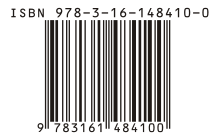
Back ISBN Afrikaans Internationale Standardbuchnummer ALS ዓለም-አቀፍ መደበኛ የመጽሐፍ ቁጥር Amharic النظام القياسي الدولي لترقيم الكتب Arabic الرقم الدولي المعياري ديال الكتاب ARY رقم دولى معيارى للكتاب ARZ আন্তৰ্জাতিক মান গ্ৰন্থ সংখ্যা Assamese ISBN AST आई॰ऍस॰बी॰ऍन॰ AWA ISBN Azerbaijani

The International Standard Book Number, ISBN, is a unique[1] commercial book identifier barcode. The ISBN system was created in the United Kingdom, in 1966, by the booksellers and stationers W.H. Smith.
Originally, it was the 9-digit Standard Book Numbering (SBN) code and still was used in 1974; it was adopted as the international standard ISO 2108 in 1970. A similar, numeric identification, the International Standard Serial Number (ISSN), identifies periodical publications such as magazines. Since January 1, 2007, ISBNs are of 13 digits, like in Bookland EAN-13.[2] The TC 46/SC 9 is responsible for the standard.
- ↑ Occasionally publishers will use an ISBN for more than one title (e.g. the first edition of "The Ultimate Alphabet" and "The Ultimate Alphabet Workbook" have the same ISBN, 0-8050-0076-3). On the other hand, books can be published with more than one ISBN: A German-as-a-second-language edition of Emil und die Detektive has the ISBNs 87-23-90157-8 (Denmark), 0-8219-1069-8 (United States), 91-21-15628-X (Sweden), 0-85048-548-7 (England) and 3-12-675495-3 (Germany).
- ↑ See Frequently Asked Questions about the new ISBN standard Archived June 10, 2007, at the Wayback Machine from ISO